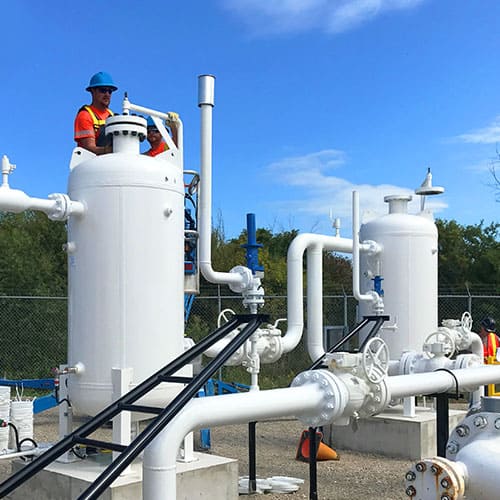Compressed Air Dryer FAQs
Frequently Asked Questions Regarding Compressed Air Dryers

What is the difference between coalescing and particulate filters?
The main difference is on a coalescing filter, the flow is going in the center of the element and will filter through the center to the outside. Contaminantes will exit through the sides and drain to the bottom of the filter. On a particulate filter, the flow is going in the sides of the element and the contaminated air is no longer flowing down the center like a coalescing filter. The contaminated air is being forced through the sides and into the center. All you need to do is rotate the head and change the arrows to the opposite direction in order to change from coalescing to particulate.
When do you need a coalescing or particulate filter?
If you are removing oil and water, then you’re best choice is a coalescing filter. If you are removing solid particles, use a particulate filter.
Which type of Deliquescent desiccant do you need?
We offer three different types of deliquescent desiccants: Dry-o-Lite, SP, and 10BF. They are all dependable, environmentally safe, cost effective, and energy free tool for a wide range of drying applications. To better determine what type of desiccant is best for your application, it can depend on the industry. Compressed air industries include examples such as blasting / painting, auto mechanics, shop tools, manufacturing, and concrete plants. Natural gas industry examples include biogas, digester gas, fuel gas, pipeline gas, and wellhead gas. For most natural gas applications, 10BF deliquescent desiccants make the most sense. For Compressed Air, the right desiccant depends on conditions and desired dew point. Dry-O-Lite achieves a 55% relative humidity or suppresses the dew point by 20 degrees Fahrenheit. SP achieves 35% relative humidity, suppressing dew point by 30 degrees Fahrenheit. And 10BF achieves 13% relative humidity or suppresses the despoint by 63 degrees Fahrenheit.
How Long do desiccants last?
Depending on your inlet conditions and type of application, desiccant performance will vary. 10BF will remove the most moisture from your air or gas lines and will achieve the highest dew point suppression. Dry-O-Lite is the leading deliquescent desiccant for compressed air systems and is the most cost-efficient.
What is "DEW POINT"?
The most common measurement of compressed air water content is dew point. Dew point is the temperature where air–or any gas– is saturated with water and moisture will begin to condense. In other words, it’s the point where dew begins to form. Dew point is always stated as a temperature. Simply put, dew point is the temperature where condensation begins.
What is the difference between pressure dew point vs. atmospheric dew point?
In compressed air applications, pressure is critical when discussing dew point . Compression and expansion of air affects its dew point. Generally speaking, compression increases dew point, and expansion (i.e. de-compression) lowers dew point. For example, consider compressed air leaving a dryer at 200 PSIG with a pressure dew point of -40º F/C @ 200 psig. If the pressure is eventually reduced to 100 psig, the pressure dew point will fall to -50 ºF @ 100 psig. If the air is further expanded to 5 psig, the pressure dew point becomes -77º F @ 5 psig.
For this reason, the phrase pressure dew point (PDP) is commonly used. This term usually refers to the dew point of the compressed air at full line pressure. Conversely the phrase atmospheric dew point refers to what the dew point would be if fully depressurized to atmospheric conditions.
How do you determine the dew point suitable for your application when selecting a compressed air dryer?
Many industrial users of compressed air specify a pressure dew point of -40⁰ F/C at line pressure. This is especially so in process industries, facilities where air lines will be exposed to cold ambient air, and systems where compressed air interacts with sensitive instruments and processes.The best and easiest way is to ask the Manufacturer what the pressure dew point (PDP) requirements are for your equipment. Another method is to calculate the dew point temperature.
How do you calculate dew point temperature?
Determine the lowest ambient temperature your compressed air piping system will be exposed to by checking the location of air lines throughout air conditioned or unheated areas. Simply take that temperature number and lower it by 20º. This will give you dew point temperature needed to prevent condensation from forming.

